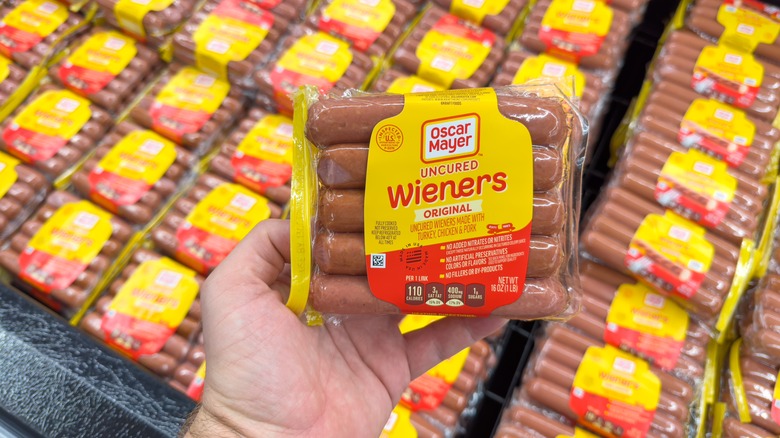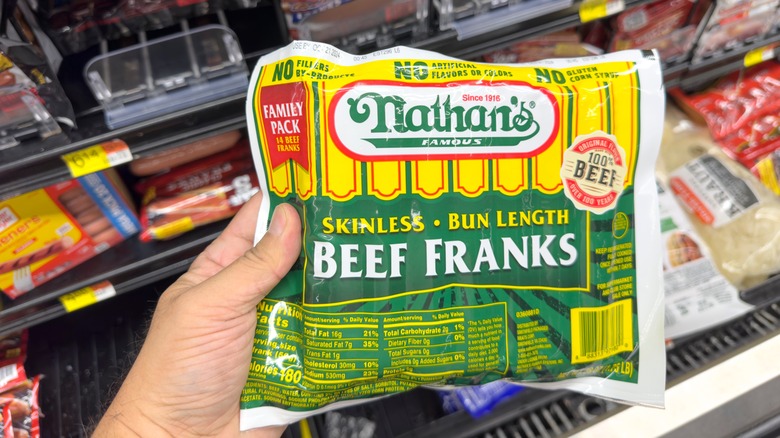The Highest And Lowest Quality Hot Dogs You'll Find At The Grocery Store
Imagine, if you will, that you are hosting a cookout. All the recipes have been selected, grandma is bringing her famous potato salad, Uncle John promises to be more careful around the campfire this year, and it's time to go grocery shopping. When you get to the cured meats refrigerator case, you know you have to select the perfect hot dogs for the occasion. But which hot dogs do you choose?
Looking at all of the options, it might feel overwhelming, to say the least. There are labels you recognize, brands you remember from your childhood, and a whole new option that seems to have appeared out of nowhere. You begin turning over the hot dogs to decide which one makes the most sense for your cookout, only to be left a little mystified by the hot dogs. Don't panic. We have you covered and prepared for your hot dog shopping expedition.
One thing is for sure: Not all hot dogs are created equal. Many franks are far inferior, and a closer look at the ingredients is absolutely necessary. So, we did the hard part for you and combed through the ingredients, pitting the different hot dog brands against one another. From there, we assigned scores to the different hot dogs based on several important categories and determine the highest and lowest hot dogs you can choose at your local grocery store. Hopefully, you'll find the perfect hot dog for your next cookout.
Low: Oscar Mayer Classic Wieners Hot Dogs
Have you ever seen the Oscar Mayer wienermobile driving down the highway? It's one of those giggle-inducing moments that's hard to forget and easy to love. And who could forget the Oscar Mayer weenie whistle featured in the Christmas classic "The Santa Clause?" It may be true that Oscar Mayer has a steady place in pop culture, but unfortunately, the hot dog quality doesn't seem to back the highest esteem we might hold for this hot dog brand.
The Oscar Mayer classic wiener hot dog is a mixture of mechanically separated chicken, turkey, and pork. This mixture of the three meats doesn't earn it any favors in our overall assessment, and the many additions of chemicals and additives don't help either. While there are several chemicals in the Oscar Mayer hot dog that we saw in other brands, a few were more unique. Potassium chloride, for one, was an interesting addition here. Potassium chloride is basically a sodium-free replacement for salt which sounds great, but since there's already salt in the hot dog, it's curious that potassium chloride would be here, too.
Outside of the meat, corn syrup, salt, and a passing mention of ambiguous flavoring, Oscar Mayer classic wieners don't have any seasonings mentioned. For the lack of substantial seasoning of any kind, many chemicals and additives, and triple combination of meat, this type of hot dog was among the lowest quality we investigated.
High: Nathan's Famous Natural Casing Beef Franks
If you're a fan of competitive eating, you no doubt know about Nathan's Famous hot dogs. After all, the brand sponsors a major 4th of July hot dog eating contest each year. In only 10 minutes, the competitors aim to scarf down as many Nathan's Famous dogs as possible. 2024's Nathan's Hot Dog winner was Patrick Bertoletti at 58 hot dogs in that short amount of time.
Now, we aren't necessarily interested in eating dozens of Nathan's Hot dogs, but these hot dogs are of pretty fine quality and do quite well in our comparisons. For one, the meat in these dogs is 100% beef. Unlike Oscar Mayer, the meat is not mechanically separated since beef cannot be mechanically separated in the same way chicken and turkey can. In terms of chemicals and additives, we saw quite a few in the ingredients list. Notably, these hot dogs were one of only two we investigated that have hydrolyzed corn protein. This is a food additive that enhances the flavor of meat and adds a savory, umami taste. Clearly, Nathan's wants the hot dogs to really exude that beefy flavor.
In the instance of the natural casing beef franks, sheep is specified as the type of casing used. Between the simplicity of the meat, the addition of the seasonings — most notably paprika — and the inclusion of a specific kind of casing, this hot dog ranks high in quality.
Low: Ball Park Franks
Some foods are so integrally linked to a specific place that it's hard to enjoy them without memories washing over us. For many, hot dogs are one of those foods. Ball Park brand hot dogs, specifically, originated in Detroit's own Tiger Stadium. Fans fell in love with the dogs, and in 1959, the hot dogs became a mainstay in Detroit grocery stores before finding their way into refrigerator cases across the country.
Unfortunately, these hot dogs rank quite low between the different brands we assessed. Although it didn't score lowest among the brands, it shares many characteristics with some of the lower quality hot dogs we saw. For one, the meat of the hot dog is a combination of chicken and pork mechanically separated. Like Oscar Mayer, Ball Park uses corn syrup as a sweetener. Of the different varieties we investigated, it was the only one that had maltodextrin, an additive that helps keep the overall flavor of a product even throughout. Instead of hydrolyzed corn protein like the Nathan's Famous brand, Ball Park uses beef stock to add more beef flavor, an addition we appreciate. However, with the meat combination and load of additives and chemicals as well as no mention of a casing, Ball Park is of lower quality.
High: Hebrew National Beef Franks
Hebrew National Beef Franks are a kosher variety of hot dog. They utilize fairly simple ingredients compared to many other brands, and share several similarities to Nathan's Famous dogs, another one of the more high quality offerings out there.
To help increase that beef flavor, the brand utilizes the additive hydrolyzed soy protein to help increase that beef flavor. Since these are kosher dogs, the presence of purely beef and the feeling that something is substantially beef flavored would be important to customers. For a sped up curing process, it also uses sodium erythorbate, an ingredient that high and low quality dogs alike frequently use. The combination of spices and 100% beef leads to a quality dog, even if it's the lowest of the higher brands we ranked.
Low: Lightlife Smart Dogs
Meat alternatives are fascinating. While they aim to be similar to the products we find across grocery stores, they are also something else entirely. Those who follow a vegan or vegetarian diet enjoy these kinds of products because it allows them to enjoy meat looking products along with their meat eating friends. Some of these not quite meat products are pretty good. Impossible burgers, for example, can be very passable for the real thing. However, the draw of these products seems to lose a whole lot of luster as soon as you start looking at the ingredients.
In the case of Lightlife Smart Dogs, they are mostly a soy based product with a lot of additives and chemicals used to create something that would look like an actual hot dog. That said, there are some seasonings present, including garlic powder and something called a garlic juice concentrate. The highest quality hot dogs we found had the lowest concentration of chemicals and additives, but Lightlife smart dogs are at an immediate disadvantage because they must rely on these items to create something that looks like a hot dog. So, while we can't necessarily recommend Lightlife smart dogs as a high quality hot dog choice, if you follow a vegan or vegetarian diet and it's the only option, it does have some flavoring additives to it that might make ignoring the chemistry laden ingredients list worthwhile.
High: Applegate Organics The Great Organic Uncured Beef Hot Dog
The same customers who pay close attention to labeling on egg crates will be interested in Applegate Organics. This brand is committed to using products that come from animals that are raised humanely, fed a specific kind of diet, and enjoy life a certain way. This is immediately clear when you look at the package of the organic uncured beef hot dog because the very first ingredient is organic grass-fed beef. Meaning, throughout its life, the cow ate grass rather than a diet that may not have been as suitable.
Looking further in the list, you can find immediately identifiable ingredients. In fact, many items listed are probably ones that you even have in your own cabinets or refrigerator. It says a whole lot when minimal research is needed to determine what an ingredient actually is. The fact that you won't be Googling ingredients as you shop does a lot for the customer who's concerned about what specifically is in your food. In pitting different hot dogs against each other, Applegate Organics scored at the very top, ranking highly for a single meat hot dog, being free of additives and having seasonings.
Low: Stahl-Meyer Hot Dogs
As soon as you start investigating hot dog brands, you begin noticing how hot dog brands that use chemicals and additives advertise themselves. Stahl-Meyer, for one, advertises right on the package that it's made using chicken, pork, and beef. And then it prominently states that there are no artificial flavors, colors, or byproducts. While that might be the case, instead, there's a whole slew of other chemicals some of the lower quality hot dogs use.
We saw the addition of potassium lactate, which helps extend shelf life, and is used in both high and low quality hot dogs. And there is also sodium phosphate, which seems to appear mostly in the lower quality hot dogs, from what we observed. Sodium phosphate is a chemical that can keep an item extra juicy because it retains water. Generally, in small amounts it's not considered a problem, but could become a health concern in larger quantities.
Even though the company advertises many items that it doesn't use in its hot dogs, it still uses quite a few additives that discourage us from marking it as a higher quality hot dog. Also notable, although the chicken and pork are listed towards the beginning of the ingredients, beef was listed far below many of the others, in fact in the less than 2% category. So, while Stahl-Meyer advertises beef in the hot dog, the actual amount seems pretty minimal.
High: Sabrett Natural Casing Beef Frankfurters
For one of the more iconic hot dogs in America, you'll want to use the Sabrett brand natural casing beef frankfurters as your base. A New York hot dog, also known as a dirty water dog, uses this brand as its base, and gets the topping of sauerkraut, mustard, and a tomato based onion sauce that is tangy and savory and tomatoey all in one bite.
Sabrett hot dogs bear a striking resemblance in ingredients to Nathan's Famous hot dogs, but with some notable additions. For example, these have garlic powder as well as a hickory smoke flavor we imagine must accent the tomato sauce quite nicely. The reason these hot dogs are so high in quality is that they contain only beef for the meat, have minimal chemicals and additives, include seasonings, and also note that the hot dog is in a sheep casing.
Low: Hofmann German Franks
Hofmann German Franks have a rather substantial history, dating back to 1879, and the recipes originate in Germany. However, even with this lengthy history, these dogs carry a lower designation on our list due to the amount of chemicals we found in the ingredients.
None of the ingredients listed were anything out of sorts compared to other lower quality dogs we saw, but we did find it notable that these franks actually listed the natural casing it came from right on the list of ingredients. In this case, the casing comes from lamb. In terms of meat, there are three listed: pork, beef, and veal. This is the only hot dog that lists veal as one of its meats. While some may not struggle with veal being among The ingredients, others may look at this as a pitfall, given that veal comes from a calf rather than an adult cow.
High: Trader Joe's Uncured Beef Hot Dogs
It's easy to love a Trader Joe's run. You're almost always guaranteed to find a new product that you'll enjoy, even if it involves stumbling through a crowded grocery store. Clearly, the secret deliciousness of Trader Joe's is out, and people are hungry for it. Us among them, admittedly. While some products become gold star standards on the Trader Joe all-star roster, some fall a little to the wayside, even if they should be among the more favorite options. We believe that the beef hot dogs you can find a Trader Joe's should probably be among some of the more favorites out there.
You don't need to get much further than the ingredients list to discover why these hot dogs are special. We found the ingredients listed to be similar to what we saw from Applegate Organics, with nothing on the list appearing to be extraordinary or something developed in a lab. Due to the single meat listed in the ingredients, and substantial lack of lab developed chemicals and additives like we see in many other hot dogs, this one is easily one of the higher ranking dogs on our list. Not to mention, it also has seasonings like garlic powder and the ambiguously listed "spices."
Low: Bar-S Beef Bun Length Franks
Bar-S' main goal seems to be bringing families meat without being too expensive. While this goal is noble, the quality of the hot dogs, at least, is lacking. To begin, the meat included is three parts: chicken, pork, and a meager amount of beef. Add to that a lack of identifiable seasonings, additives and chemicals, and you've got a low ranking hot dog.
While combing through the ingredients, we found several that didn't appear on any other hot dogs we looked into. Modified corn starch, potassium acetate, sodium erythorbate, and oleoresin of paprika were all new to us. While modified corn starch is a thickener for foods, potassium acetate can be an item that adds an acidic flavor, and sodium erythorbate helps with the dog's curing. Bar-S adds oleoresin of paprika to create the appropriate coloring. All told, that's a whole lot of ingredients that make us a little squirmy about recommending a hot dog that feels like it could have been created in more of a lab than kitchen.
Methodology
To assess the quality of each hot dog, we first pulled apart the ingredient list. We determined the types of meat that were used, whether there were chemicals and additives, the presence of specific seasonings, and if there was a casing type named.
After reading the ingredients, we gave the hot dogs scores out of six. For meat, if a hot dog had one variety of meat listed, it earned two points, two meats would give it one point, and three would give it zero points. If there are no chemicals or additives, the hot dog would earn another two points, and hot dogs also earn a point for having seasonings listed on the ingredients. If there was a casing listed under ingredients — and we found this to be an extreme rarity — the hot dog also earned another point. From there, we ranked the hot dogs, and the ones scoring zero or one point overall had a low ranking, while the ones with three or more points earned a high ranking.












